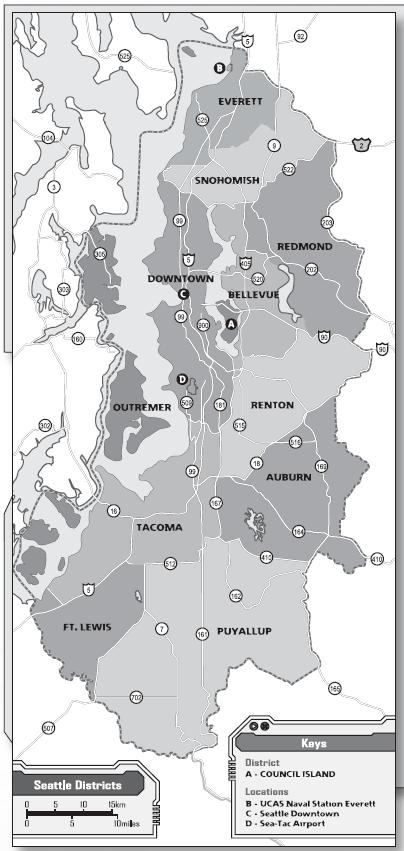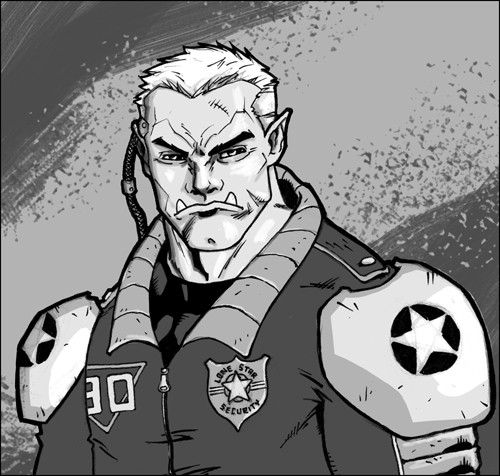Know Where You Are and Watch Your Hoop
March 9, 2057
Alright chummers, we all like to posture and bust a frill about getting away clean or geeking every last hondo that throws down on you, but let's face facts: the real world isn't like Karl Kombatmage. You can't just sling mojo and lead at the cops all day, no matter even if you've got a daddy on the roof. The fact is, there will be a time when the 'Star comes after you, your keys are on the tea, and you've got to get out of London, as the kids say. In order to understand your chances of escape, the opposition you'll face, and the chance of you simply being shaken down by the Star for doing nothing but being TIP (Trog In Public), you'd best wrap your mind around the Lone Star security ratings for the Seattle Metroplex.
-Captain Chaos
Security Ratings
Security ratings are defined by the amount of coverage that Lone Star or
any other security agency is paid to give an area. The ratings are
universal, and have even come into common parlance: Renraku touts their
Seattle arcology as “Triple-A security for 90,000 people." Lone Star’s
coverage ends where a corporation’s property begins. A business in the
Z-Zone may have Renraku Red Samurai or Knight Errant elite forces
guarding it, even though Lone Star wouldn’t go near the area for all the
nuyen in Zurich Orbital.
AAA rating
The AAA rating is the highest available level of security, usually
reserved for upper-class enclaves (usually Luxury and High lifestyle)
and businesses willing to pay to have the area outside their property
patrolled. AAA security also includes “proactive and deterrent
measures.” This means both visible and hidden security measures
(PanicButton™ booths open and working), patrols on foot and in vehicles,
astral security patrols using spirits and magicians, security drones
and security riggers monitoring cameras. The police guarding AAA areas
are always the finest, with the most duty hours logged. An assignment to
an area of AAA security is considered to be the ultimate promotion, and
no one wants to be demoted for lack of effort.
Response to even the most minor crime is practically immediate.
Security providers are reluctant to leave any investigation open,
regardless of the cost to pursue it. Even if closing the investigation
means bringing in chumps to take the fall and then releasing them later,
that’s what they’ll do, because crime is not allowed to “succeed” in
these areas.
AA rating
The AA rating is usually reserved for High-lifestyle areas and
businesses that want constant coverage but don’t want to pay for
around-the-clock deterrent measures. Patrols cover the area 24 hours a
day, but are less frequent. Astral patrols take place on an irregular
schedule, and there may not be a security rigger system set up. Drones
and sprits may guard certain areas in place of humans.
Response is prompt, but will take a back seat if something is
going down in a AAA area. The standard
officers respond first and only call in a specialist if needed.
Assignment to this area is also viewed as a promotion, so officers
investigate complaints thoroughly, if not as quickly as in a AAA area.
A rating
Most of the metroplex falls into rating A security. This level of
security generally covers any area with a Middle lifestyle, which
accounts for the largest percentage of residential sections of Seattle.
These areas receive excellent security, but the level of coverage
decreases dramatically from the AA level, primarily because Lone Star
lacks sufficient personnel. These areas usually have
regular street patrols but only rare astral, drone or security- rigger
presence.
Law enforcement in these areas is basically a call-and-response
system. This means there are actually a lot of PanicButton booths and
neighborhood watch groups and other organizations willing to call in at
the slightest hint of criminal activity. This “community policing” tends
to result in a higher number of false alarms, which in turn means
response time is a bit slower.
B rating
Rating B is usual for areas comprised primarily of commercial
properties rather than residential, such as industrial parks, office
complexes and suburban manufacturing— things that have existed
side-by-side with middle class residential areas since the 1960s. Since
these areas are usually “high criminal target areas” (in other
words,prime targets for shadowrunners), Lone Star’s standard response is
to send a minimum of four patrol officers with an elite officer and
security/combat mage on standby.
The constant cycle of urban renewal is currently washing over
such areas in Seattle and rehabbers are
turning older buildings into art galleries, loft apartments and other
low middle-class businesses and dwellings. This trend is spreading Lone
Star even thinner and giving these areas a precarious hold on their B
rating.
C and D rating
Ratings C and D are the Low lifestyle versions of ratings A and B
security; the coverage is similar for both ratings, but C is for
residential and D is for business zones. Infrequent patrols and poorly
maintained PanicButton booths mean that crime here is reported less
often and therefore enforced less often. The security services in these
areas make no real effort to prevent crimes before they happen. Lone
Star and other security forces receive a hostile reception from the
general populace, which accuses law enforcement of being less than
thorough in investigations involving crimes at businesses in these
areas. Most officers begin their training in these areas and try to get
promoted out as quickly as possible, though the savvy officers,
especially detectives, maintain their contacts
from their beat days in these areas because this is where the
information flows. Except for undercover officers and detectives, the
usual response to any call here consists of six to eight fully armored
officers in an armored Citymaster with two patrol vehicles and one
combat mage. Drones are sometimes used to reduce the risk of injury to
officers.
E rating
Rating E areas are considered slums (Squatter and Street lifestyles).
Yeah, people live there, but they aren’t “real” people (they don’t have
SINs, after all), so why make the effort? Lone Star does not assign
patrols to such areas or make any effort to prevent crimes from
happening.
They will respond if the victim has a SIN and calls in a
complaint himself, or if the violence makes the headlines or threatens
to spill over into more “important” areas. When the Star does respond,
it’s at a very high level, usually including two Citymasters filled with
twelve to fifteen officers in heavy armor, plus one rigger per vehicle
to handle drones and the Citymaster’s weapons, and
at least two combat mages. Such a force is always lead by an elite
officer. The slums are an excellent place for detectives and undercover
operatives to maintain contacts.
Z rating
In rating Z areas (also known as Z-Zones), humanity has devolved to a
state of tribes, anarchy and a complete lack of any type of “normal
society.” It’s survival of the fittest, and the law doesn’t care who
wins and who loses as long as everyone stays within the boundaries. The
law considers it more important to keep the area contained than to
prevent or solve crimes, so there is no attempt to enforce the laws in
these areas. In many cases, walls or other natural boundaries actually
separate these areas from the rest of the sprawl.
Only if pursuing an investigation will the Star enter the Z-Zone,
and when they do they are prepared for war. The standard force is a
minimum of three Citymasters (twenty-five officers in full armor) with
air support from armored helicopters; one rigger per vehicle handling
the weapon mounts and one extra rigger maintaining drone coverage; at
least five combat mages and one combat decker maintaining communication
with headquarters at all times; and three elite officers running the
show — one coordinating the mages, one in the air and one dealing with
the troops on the ground. Lone Star considers Z-Zone duty to be hazard
duty, and officers assigned to these details receive three times their
normal wages and a week off after any operation in these areas.














